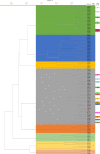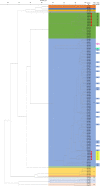Comparison of fast Fourier transform infrared spectroscopy biotyping with whole genome sequencing-based genotyping in common nosocomial pathogens
- PMID: 35962141
- PMCID: PMC9482911
- DOI: 10.1007/s00216-022-04270-6
Comparison of fast Fourier transform infrared spectroscopy biotyping with whole genome sequencing-based genotyping in common nosocomial pathogens
Abstract
Early detection of bacterial transmission and outbreaks in hospitals is important because nosocomial infections can result in health complications and longer hospitalization. Current practice to detect outbreaks uses genotyping methods amplified fragment length polymorphism (AFLP) and whole genome sequencing (WGS), which are not suitable methods for real-time transmission screening of both susceptible and resistant bacteria. The aim was to assess the typing technique Fourier transform infrared (FTIR) spectroscopy as real-time screening method to discriminate large amounts of susceptible and resistant bacteria at strain level when there is no evident outbreak in comparison with the WGS reference. Isolates of past hospital outbreak strains of Acinetobacter baumannii/calcoaceticus complex (n = 25), Escherichia coli (n = 31), Enterococcus faecium (n = 22), Staphylococcus aureus (n = 37) and Pseudomonas aeruginosa (n = 30) were used for validation of FTIR. Subsequently, Enterococcus faecalis (n = 106) and Enterococcus faecium (n = 104) isolates from weekly routine screening samples when no potential outbreak was present were analysed. FTIR showed reproducibility and congruence of cluster composition with WGS for A. baumannii/calcoaceticus complex and E. faecium outbreak isolates. The FTIR results of E. faecalis and E. faecium isolates from routine samples showed reproducibility, but the congruence of cluster composition with WGS was low. For A. baumannii/calcoaceticus complex and E. faecium outbreak isolates, FTIR appears to be a discriminatory typing tool. However, our study shows the discriminatory power is too low to screen real-time for transmission of E. faecium and E. faecalis at patient wards based on isolates acquired in routine surveillance cultures when there is no clear suspicion of an ongoing outbreak.
Keywords: Bacteria; Bacterial typing; Fourier transform infrared spectroscopy; Whole genome sequencing.
© 2022. The Author(s).
Conflict of interest statement
The authors declare no competing interests.
Figures


References
-
- Quintelas C, Ferreira EC, Lopes JA, Sousa C. An overview of the evolution of infrared spectroscopy applied to bacterial typing. Biotechnol J. 2018;13(1). 10.1002/biot.201700449 - PubMed
Publication types
MeSH terms
Grants and funding
LinkOut - more resources
Full Text Sources
Other Literature Sources
Miscellaneous

